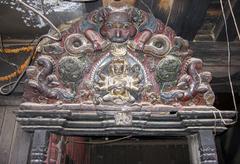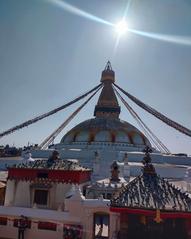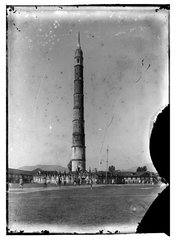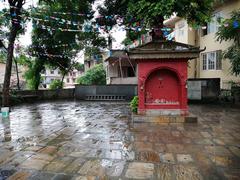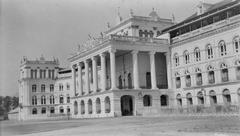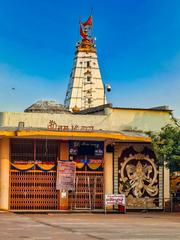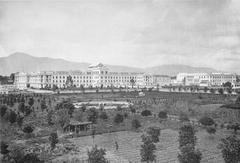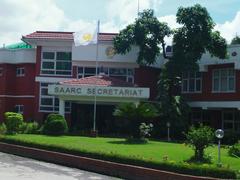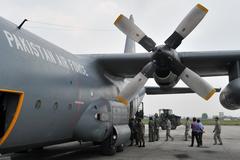Indra Chowk Kathmandu: Visiting Hours, Tickets, and Historical Sites Guide
Date: 04/07/2025
Introduction: The Significance of Indra Chowk
Indra Chowk, at the vibrant heart of Kathmandu’s old city, is a living canvas of Nepal’s spiritual, cultural, and commercial heritage. Dating back to the Malla period, it played a pivotal role as a juncture on the ancient India-Tibet trade route, shaping Kathmandu’s emergence as a center of trade, religion, and royal power. Named after Indra, the Hindu god of rain and king of heaven, Indra Chowk is deeply woven into the city’s spiritual fabric, hosting major festivals such as Indra Jatra—an event that draws thousands for its masked dances, chariot processions, and ritual ceremonies.
Beyond its religious importance, Indra Chowk is a bustling marketplace renowned for textiles, handicrafts, and religious artifacts produced by local artisans. Its architecture is a testament to Newar traditions, with intricately carved wooden windows and tiered pagoda roofs that have been preserved despite the challenges of earthquakes and urban development. Indra Chowk’s open design connects six major streets, making it a dynamic urban hub that continues to play a vital role in Kathmandu’s festivals, commerce, and social interactions.
The square is freely accessible at all times, with its liveliest hours between 9:00 AM and 7:00 PM, when shops and temples are open. Guided tours are available, offering insights into the square’s layered history and significance. Its proximity to Kathmandu Durbar Square, Asan Bazaar, and Rani Pokhari makes Indra Chowk an essential stop for anyone exploring Kathmandu’s heritage (Nepal Database; Lonely Planet; Nepal Traveller).
Table of Contents
- Origins and Historical Evolution
- Religious and Spiritual Significance
- Cultural and Social Importance
- Architectural Landmarks and Heritage Structures
- Visiting Hours, Tickets, and Accessibility
- Festivals and Rituals
- Indra Chowk in Modern Kathmandu
- Urban Identity and Memory
- Practical Insights for Visitors
- FAQs
- Visuals and Media
- Plan Your Visit
Origins and Historical Evolution of Indra Chowk
Indra Chowk’s roots reach back to the Malla era (12th–18th centuries), when Kathmandu thrived as a nexus of trade and royal power. Its strategic location at the convergence of ancient trade routes made it a critical commercial and social hub, facilitating the flow of textiles, spices, and precious stones. The square’s proximity to Kathmandu Durbar Square further cemented its ceremonial and urban significance (Nepal Database).
Indra Chowk has long been the stage for royal processions, religious festivals, and public gatherings. Its layout reflects Malla-era urban planning, with temples and Newari houses lining its periphery. Notable structures such as the Akash Bhairav Temple and Shiva-Parvati Temple, many centuries old, have endured through restoration, particularly after events like the 2015 earthquake.
Religious and Spiritual Significance
Indra Chowk’s religious legacy is deeply entwined with both Hindu and Buddhist traditions. The square is named for Indra, and his annual festival, Indra Jatra, is Kathmandu’s most spectacular celebration, featuring masked dances, chariot processions, and vibrant rituals (Nepal Database).
The Akash Bhairav Temple, with its massive mask of the fierce deity Bhairav (a form of Shiva), is unveiled during key festivals, believed to bless and protect the city. The presence of Buddhist stupas and prayer wheels in Indra Chowk reflects Kathmandu’s religious harmony, and visitors will encounter sadhus, priests, and devotees engaged in daily rituals.
Cultural and Social Importance
Indra Chowk is a melting pot of cultures and a microcosm of Kathmandu’s dynamic street life. Its markets, especially for textiles like the iconic Nepali cap (topi) and traditional attire, have served locals and visitors for centuries. The square is also a pivotal point on the Living Goddess Kumari’s chariot route during Indra Jatra, drawing crowds from across the valley (Nepal Database).
The area’s Newari architecture—with intricately carved windows and brick facades—complements its vibrant markets and social gatherings, making Indra Chowk a key site for community interaction and cultural exchange.
Architectural Landmarks and Heritage Structures
Key sites include:
- Akash Bhairav Temple: Famed for its grand mask and Newari artistry, the temple is a focal point of religious and festive activity.
- Shiva-Parvati Temple: Exemplifying pagoda architecture and intricate woodwork.
- Rani Pokhari: A significant 17th-century pond nearby, associated with royal rituals.
- Traditional Hiti: Ancient stone water spouts highlight Kathmandu’s engineering heritage.
The preservation and restoration of these sites underscore Indra Chowk’s continued historical and cultural importance (Nepal Database).
Indra Chowk Visiting Hours, Tickets, and Accessibility
- Hours: The square is open 24/7; shops and temples are most active from 9:00 AM to 7:00 PM.
- Entry: Free access; some temples may request small donations.
- Accessibility: Pedestrian-friendly but crowded, with uneven surfaces—plan accordingly if you have mobility needs.
Guided tours, available through local operators, provide deeper historical and architectural context (Lonely Planet).
Festivals and Rituals
Indra Chowk’s identity is closely tied to festivals, most notably Indra Jatra in September. This eight-day event features the ceremonial pole raising, masked dances, and the procession of the Living Goddess Kumari’s chariot. Other processions, such as Machhindranath Jatra, also pass through the square, reinforcing its role as a spiritual and cultural focal point (Nepal Database).
Indra Chowk in Contemporary Kathmandu
Today, Indra Chowk is a vital urban node that blends tradition with modernity. Its markets buzz with vendors selling fruits, spices, and handicrafts, while rickshaws and motorbikes weave through the crowds. The square’s enduring importance is reflected in its continued use for religious festivals, social gatherings, and political demonstrations.
Indra Chowk’s Role in Urban Identity and Memory
Beyond its physical presence, Indra Chowk is a repository of collective memory and identity for the people of Kathmandu. Restoration projects and heritage walks organized by locals help preserve its story for future generations (Nepal Database).
Practical Insights for Visitors
- Best Time to Visit: During festivals (especially Indra Jatra), or daily between 9:00 AM and 7:00 PM for active markets.
- Nearby Attractions: Kathmandu Durbar Square, Asan Bazaar, Rani Pokhari.
- Tips: Dress modestly; respect temple rules; bargain in markets; use cash; be mindful of crowds and uneven streets.
Frequently Asked Questions (FAQ)
Q: What are Indra Chowk’s visiting hours?
A: The square is accessible 24/7; markets and temples are busiest from 9:00 AM to 7:00 PM.
Q: Is there an entry fee?
A: No, entry is free; some temples may ask for small donations.
Q: Are guided tours available?
A: Yes, through local tour operators and tourism centers.
Q: Is Indra Chowk accessible for people with disabilities?
A: Accessibility is limited due to uneven pavements and crowds.
Q: What are the best nearby attractions?
A: Kathmandu Durbar Square, Asan Bazaar, and Rani Pokhari.
Visuals and Media
To better appreciate Indra Chowk, seek out high-quality images and virtual tours. Photos of the Akash Bhairav Temple, festival processions, and bustling markets offer valuable context. Official tourism sites offer interactive maps and virtual experiences.
Plan Your Visit
Download the Audiala app for guided tours, festival updates, and cultural insights. Check related articles for more on Kathmandu’s historical sites and festivals.
Marketplace Dynamics and Shopping Experiences
Indra Chowk is a commercial artery of Kathmandu, famous for its markets:
- Pote Bazaar: Known for colorful bead necklaces (Tusk Travel).
- Raki Bazaar: Sells clothes and woolen goods at competitive prices.
- Handicrafts: Brassware, religious masks, singing bowls, and antiques abound (Volunteer FDIP).
Bargaining is customary; cash is king. The market bustles most in the mornings and late afternoons (Holidify).
Culinary Experiences
Indra Chowk is a hotspot for street food:
- Lassi: Sweet, spiced yogurt drink (Volunteer FDIP).
- Momos: Nepali dumplings (ByFood).
- Sel Roti, Samosas, Bara: Local snacks (Green Valley Nepal Treks).
- Chhoila, Yomari: Traditional Newari dishes.
Guided food tours are available, and busy stalls are recommended for food safety.
Integration with Neighboring Markets
Indra Chowk connects with:
- Asan Bazaar: Spices and daily goods (GPSmyCity).
- New Road: Modern shopping (Tusk Travel).
- Thamel: Tourist hub (Holidify).
These links make for a seamless cultural and commercial experience.
Getting to Indra Chowk
A 10–15 minute walk from Thamel or close to Kathmandu Durbar Square, Indra Chowk is accessible by foot, taxi, or local transport (Laure Wanders). Walking is often preferred due to narrow, crowded streets.
Facilities and Safety
- Toilets: Limited; restaurants/hotels nearby.
- Seating: Few benches; temple steps often used.
- Payment: Cash preferred; ATMs nearby.
- Personal Safety: Keep valuables secure; be cautious of pickpockets.
- Health: Avoid tap water; use sanitizer; choose hygienic food vendors (Third Eye Traveller).
- Emergency: Police (100), Tourist Police near Durbar Square, Bir Hospital nearby.
Cultural Etiquette
- Dress modestly; remove shoes in temples.
- Always ask before photographing people.
- Respect worshippers and local customs.
Festival Times and Environmental Tips
During festivals like Indra Jatra, expect crowds and road closures. Stay with your group and be respectful when photographing events (Thrillophilia).
- Avoid littering; noise can be high—earplugs may help.
- English is widely spoken in tourist areas; local guides offer insights.
COVID-19 and Health Updates
As of July 2025, restrictions are relaxed, but check for current guidelines, carry a mask, and maintain hygiene.
Summary
Indra Chowk is an essential stop for those seeking the heart of Kathmandu’s history, markets, and festivals. Its blend of architecture, commerce, and living tradition offers an immersive experience for every visitor. For updated information and guided tours, use resources like the Audiala app and official tourism platforms (Nepal Database; Lonely Planet; Thrillophilia).
References
- Nepal Database
- Lonely Planet
- Nepal Traveller
- Nepal Alibaba Treks
- Thrillophilia
- Laure Wanders
- Volunteer FDIP
- ByFood
- Green Valley Nepal Treks
- The Longest Way Home
- Wanderlog
- Tusk Travel
- Holidify
- GPSmyCity
- Third Eye Traveller
